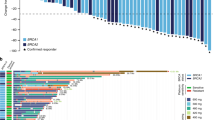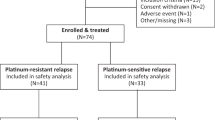Summary
We investigated the safety and efficacy of 90 mg/m2 bendamustine HCL, administered intravenously on days 1 and 2 every 28 days in 10 women with platinum and taxane resistant epithelial ovarian cancer. There were no objective tumor responses observed; 2 patients had stable disease. Plasma samples collected at pre-treatment and end of cycle one were analyzed for changes in circulating total cytokeratin 18 and caspase cleaved cytokeratin 18 as exploratory early biomarkers of bendamustine-induced tumor cell death. All patients had measureable levels of both total and cleaved caspase 3 cytokeratin 18, but no relationship with response was possible due to the lack of clinical benefit in treated patients. Due to the high incidence of adverse events and absence of objective responses, only ten patients were treated as predefined by the Simon Two-Stage Design in the protocol. Overall, the regimen was not well tolerated and was associated with fatigue and a greater number of gastrointestinal side effects as compared to previously reported experiences in different patient populations. However, our study subjects did experience less bone marrow suppression. The lack of tolerability could reflect the degree of tumor burden within the peritoneal cavity as well as the high number of prior regimens (median of 5) received by the patients participating in this study.


Similar content being viewed by others
References
Siegel R, Naishadham D, Jemal A (2012) Cancer statistics, 2012. CA Cancer J Clin 62:10–29
Han ES, Lin P, Wakabayashi M (2009) Current status on biologic therapies in the treatment of epithelial ovarian cancer. Curr Treat Options Oncol 10:54–66
Sehouli J, Stengel D, Oskay-Oezcelik G, Zeimet AG, Sommer H, Klare P, Stauch M, Paulenz A, Camara O, Keil E, Lichtenegger W (2008) Nonplatinum topotecan combinations versus topotecan alone for recurrent ovarian cancer: results of a phase III study of the North-Eastern German Society of Gynecological Oncology Ovarian Cancer Study Group. J Clin Oncol 26:3176–3182
Burger RA, Brady MF, Bookman MA, Fleming GF, Monk BJ, Huang H, Mannel RS, Homesley HD, Fowler J, Greer BE, Boente M, Birrer MJ, Liang SX (2011) Incorporation of bevacizumab in the primary treatment of ovarian cancer. N Engl J Med 365:2473–2483
Mantia-Smaldone GM, Edwards RP, Vlad AM (2011) Targeted treatment of recurrent platinum-resistant ovarian cancer: current and emerging therapies. Cancer Manag Res 3:25–38
Leoni LM, Bailey B, Reifert J, Bendall HH, Zeller RW, Corbeil J, Elliott G, Niemeyer CC (2008) Bendamustine (Treanda) displays a distinct pattern of cytotoxicity and unique mechanistic features compared with other alkylating agents. Clin Cancer Res 14:309–317
Gandhi V (2002) Metabolism and mechanisms of action of bendamustine: rationales for combination therapies. Semin Oncol 29:4–11
Teichert J, Baumann F, Chao Q, Franklin C, Bailey B, Hennig L, Caca K, Schoppmeyer K, Patzak U, Preiss R (2007) Characterization of two phase I metabolites of bendamustine in human liver microsomes and in cancer patients treated with bendamustine hydrochloride. Cancer Chemother Pharmacol 59:759–770
Gaul L, Mandl-Weber S, Baumann P, Emmerich B, Schmidmaier R (2008) Bendamustine induces G2 cell cycle arrest and apoptosis in myeloma cells: the role of ATM-Chk2-Cdc25A and ATM-p53-p21-pathways. J Cancer Res Clin Oncol 134:245–253
Roue G, Lopez-Guerra M, Milpied P, Perez-Galan P, Villamor N, Montserrat E, Campo E, Colomer D (2008) Bendamustine is effective in p53-deficient B-cell neoplasms and requires oxidative stress and caspase-independent signaling. Clin Cancer Res 14:6907–6915
Leoni LM (2011) Bendamustine: rescue of an effective antineoplastic agent from the mid-twentieth century. Semin Hematol 48(1):S4–S11
Balfour JA, Goa KL (2001) Bendamustine. Drugs 61:631–638
Kollmannsberger C, Gerl A, Schleucher N, Beyer J, Kuczyk M, Rick O, Casper J, Sosada M, Rie C, Kanz L, Bokemeyer C (2000) Phase II study of bendamustine in patients with relapsed or cisplatin-refractory germ cell cancer. Anticancer Drugs 11:535–539
Chambers SK, Clouser MC, Baker AF, Roe DJ, Cui H, Brewer MA, Hatch KD, Gordon MS, Janicek MF, Isaacs JD, Gordon AN, Nagle RB, Wright HM, Cohen JL, Alberts DS (2010) Overexpression of tumor vascular endothelial growth factor A may portend an increased likelihood of progression in a phase II trial of bevacizumab and erlotinib in resistant ovarian cancer. Clin Cancer Res 16:5320–5328
Tageja N (2011) Bendamustine: safety and efficacy in the management of indolent non-hodgkins lymphoma. Clin Med Insights Oncol 5:145–156
Owen JS, Melhem M, Passarell JA, D’Andrea D, Darwish M, Kahl B (2010) Bendamustine pharmacokinetic profile and exposure-response relationships in patients with indolent non-Hodgkin’s lymphoma. Cancer Chemother Pharmacol 66:1039–1049
Integrated genomic analyses of ovarian carcinoma. Nature 474:609–615, 2011
Cummings J, Ranson M, Lacasse E, Ganganagari JR, St-Jean M, Jayson G, Durkin J, Dive C (2006) Method validation and preliminary qualification of pharmacodynamic biomarkers employed to evaluate the clinical efficacy of an antisense compound (AEG35156) targeted to the X-linked inhibitor of apoptosis protein XIAP. Br J Cancer 95:42–48
Demiray M, Ulukaya EE, Arslan M, Gokgoz S, Saraydaroglu O, Ercan I, Evrensel T, Manavoglu O (2006) Response to neoadjuvant chemotherapy in breast cancer could be predictable by measuring a novel serum apoptosis product, caspase-cleaved cytokeratin 18: a prospective pilot study. Cancer Invest 24:669–676
Bilici A, Ustaalioglu BB, Ercan S, Orcun A, Seker M, Salepci T, Gumus M (2011) Is there any impact of plasma M30 and M65 levels on progression-free survival of patients with advanced gastric cancer? Cancer Chemother Pharmacol 68:309–316
Acknowledgements
Partial funding for this study was provided by an investigator initiated grant from Teva, Frazer, Pennsylvania. Additional support was provided by P50 CA95060 from the National Cancer Institute including contributions from the Clinical Research and Biometry shared services of the Arizona Cancer Center, Tucson, AZ. The contents of this manuscript are solely the responsibility of the authors and do not necessarily represent the official views of Teva or the National Cancer Institute. We would like to thank Erin A. Maine, B.S. technical assistance.
Conflicts of Interest
None of the authors have any conflicts to disclose.
Author information
Authors and Affiliations
Corresponding author
Rights and permissions
About this article
Cite this article
Baker, A.F., Roe, D.J., Laughren, C. et al. Investigation of bendamustine HCL in a Phase 2 study in women with resistant ovarian cancer. Invest New Drugs 31, 160–166 (2013). https://doi.org/10.1007/s10637-012-9827-5
Received:
Accepted:
Published:
Issue Date:
DOI: https://doi.org/10.1007/s10637-012-9827-5




